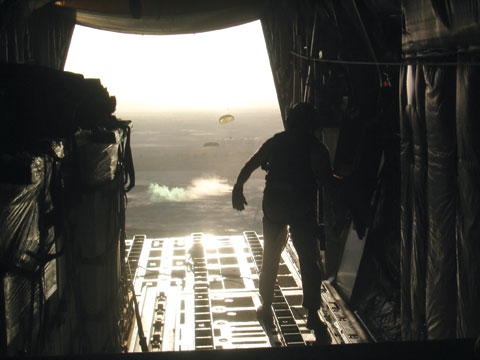 Sean Naylor’s new book chronicles the birth and evolution of Joint Special Operations Command (JSOC), which was founded in 1980. This was in direct response to the Iran Hostage Crisis of April 24, 1980 – the disastrous attempt to rescue 52 American hostages held by Iran, known as Operation Eagle Claw. The mandate of JSOC is to identify and eradicate terrorists and terrorist cells around the world.
Sean Naylor’s new book chronicles the birth and evolution of Joint Special Operations Command (JSOC), which was founded in 1980. This was in direct response to the Iran Hostage Crisis of April 24, 1980 – the disastrous attempt to rescue 52 American hostages held by Iran, known as Operation Eagle Claw. The mandate of JSOC is to identify and eradicate terrorists and terrorist cells around the world.
In 1986, political influences such as Senator Barry Goldwater sponsored and supported the Goldwater-Nichols Defense Reorganization Act of 1986 that created the United States Special Operations Command (USSOCOM), as the administrative, selection and training support for JSOC and other special operations organizations. In the wake of the terrorist attacks on September 11, 2001 (9/11), Naylor notes former Secretary of Defense, Donald Rumsfeld, was responsible for guiding USSOCOM to take on the global counter terrorist mission and support JSOC, to address the terrorist threat and meet the challenges of the post-9/11 world. JSOC had, until then, existed ‘below the radar’ and was viewed as a cumbersome organization. In the wake of 9/11, it’s reporting to the National Command Authority (NCA) consisting of the American President and Secretary of Defense demanded that it become a much more operationally agile and responsive organization to the NCA leadership – thanks in part to the demands of Rumsfeld.
JSOC has the responsibility to use highly selected and trained special operations forces personnel, combined with a well-honed and focussed ‘all source’ intelligence capability to enable JSOC to respond rapidly to strategic level national requirements. The JSOC Task Force includes the Naval Special Warfare Development Group (DEVGRU), i.e. Seal Team 6; the U.S. Army First Special Operational Detachment or Delta Force; the US Air Force 24th Special Tactics Squadron; units from the Army’s 75th Ranger Regiment; and the 160 Special Operations Aviation Regiment, i.e. Task Force 160. JSOC has a fully integrated command architecture, including intelligence operators and analysts who relentlessly track targets of interest around the globe and seek to provide the ‘actionable intelligence’ that is critical to 3FEA—Find , Fix, Finish, Exploit, Analyse, a cycle that enables a capture or kill mission assignment. As a result, JSOC is designed as an elite commando/raiding force that has a highly honed intelligence capability to undertake low visibility special mission assignments of a tactical nature that has strategic impact. Unlike conventional military forces, JSOC is not designed, equipped or capable of holding ground.
Like other elite special operations force (SOF) organizations, JSOC’s units are successful due to their intelligence preparation, combined with their individual and team skills. These depend upon the synergy created by combining sound planning, surprise, speed of action and targeted violence. Naylor reveals JSOC’s successes, in particular their ‘man hunting capabilities’ and locating and killing key strategic personalities such as Saddam Hussein, Osama bin Laden and Al Qaeda in Iraq (AQI) leader, Abu Musab al-Zarqawi. (The AQI later morphed into the Islamic State. Through numerous exclusive interviews, Naylor’s ability to penetrate JSOC’s secretive SOF community gives the reader a balanced insight into the activities, political issues, successes, failures and frustrations experienced by JSOC over the past 35 years.
JSOC has been commanded by some of the best-known innovative military leaders of our time, such as General Stanley McChrystal and Admiral William H. McRaven. Naylor acknowledges that the Director of Intelligence for US Central Command, Michael T. Flynn, facilitated the development of a full-spectrum intelligence capability that integrated reconnaissance and surveillance capabilities, as well as humint intelligence capability. Flynn embedded representatives of the Central Intelligence Agency (CIA) into the intelligence architecture to enable the generation of timely and accurate intelligence. Combined with a dedicated and relentless group of elite soldiers, this capacity has enabled JSOC’s continued success to target terrorist leadership, conduct capture or kill operations and disrupt terrorist networks in Afghanistan, Iraq and likely Syria, as well as a host of other nations where they operate.
Naylor’s book is also about the transformation from a nascent JSOC organization that was initially focused on a slow-moving, methodical, command-and-control centric approach, dedicated to the counter terrorist/hostage-rescue mission to a force that is responsive, well supported and ruthlessly innovative and empowered. This book is a must-read for those interested in how the ‘Long War’, formerly known as the Global War on Terrorism is operationalized by JSOC, the challenges JSOC has faced, and how they have adapted to the present realities. Sean Naylor has written an excellent study that provides the reader an appreciation of the myriad of challenges faced by the highly dedicated and professional men and women within JSOC.
Naylor has provided a most useful insight into the genesis and history of JSOC, its recent operations in the war against terrorism, and a testimony to these ‘quiet professionals’. A book worthy of its price and the time spent reading it.








